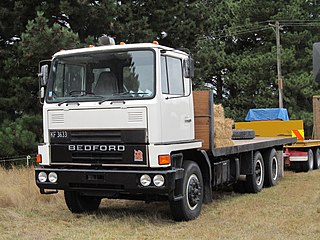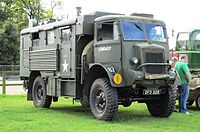
Vauxhall Motors is a British car company headquartered in Chalton, Bedfordshire, England. Vauxhall became a subsidiary of Stellantis in January 2021, having previously been owned by General Motors since 1925.

The automotive industry in the United Kingdom is now best known for premium and sports car marques including: Aston Martin, McLaren, Bentley, Rolls-Royce, Jaguar, Land Rover, Mini and Lotus. Specialised sports car companies include: Ariel, BAC, Morgan, Caterham, AC Cars, Gordan Murray, TVR, Noble, Radical, Ginetta, Ultima Sports, Westfield, Lister, Arash and David Brown. Volume car manufacturers with a major presence in the UK include: Nissan, Toyota, Mini and Vauxhall. Commercial vehicle manufacturers active in the UK include Alexander Dennis, Dennis Eagle, IBC Vehicles, Leyland Trucks, TEVVA and the London Electric Vehicle Company.

British Leyland was a British automotive engineering and manufacturing conglomerate formed in 1968 as British Leyland Motor Corporation Ltd (BLMC), following the merger of Leyland Motors and British Motor Holdings. It was partly nationalised in 1975, when the UK government created a holding company called British Leyland, later renamed BL in 1978. It incorporated much of the British-owned motor vehicle industry, which in 1968 had a 40% share of the UK car market, with its history going back to 1895. Despite containing profitable marques such as Jaguar, Rover, and Land Rover, as well as the best-selling Mini, BLMC had a troubled history, leading to its eventual collapse in 1975 and subsequent part-nationalisation.

Isuzu Motors Ltd., commonly known as Isuzu, is a Japanese multinational automobile manufacturer headquartered in Yokohama, Kanagawa Prefecture. Its principal activity is the production, marketing and sale of Isuzu commercial vehicles and diesel engines.

The Renault Trafic is a light commercial van produced by the French automaker Renault since 1980. It has also been marketed as the Fiat Talento, the Nissan NV300, the Nissan Primastar and the Mitsubishi Express. Until 2019, it was also sold as the Opel/Vauxhall Vivaro by Opel and its associated company Vauxhall. From early 2022 onwards, the van is also marketed by Renault Trucks as the Renault Trucks Trafic.

Commer was a British manufacturer of commercial and military vehicles from 1905 until 1979. Commer vehicles included car-derived vans, light vans, medium to heavy commercial trucks, and buses. The company also designed and built some of its own diesel engines for its heavy commercial vehicles.

Chrysler Europe was the American automotive company Chrysler's operations in Europe from 1967 through 1978. It was formed from the merger of the French Simca, British Rootes and Spanish Barreiros companies. In 1978, Chrysler divested these operations to PSA Peugeot Citroën.

Duple Coachbuilders was a coach and bus bodybuilder in England from 1919 until 1989.
Bedford Vehicles, usually shortened to just Bedford, was a brand of vehicle manufactured by Vauxhall Motors, then a subsidiary of multinational corporation General Motors. Established in April 1931, Bedford Vehicles was set up to build commercial vehicles. The company was a leading international lorry brand, with substantial export sales of light, medium, and heavy lorries throughout the world.

General Motors Europe was the European subsidiary of the American automaker General Motors ("GM"). The subsidiary was established by GM in 1986 and operated 14 production and assembly facilities in 9 countries, and employed around 54,500 people. GM's core European brands were Vauxhall and Opel, which both sell much the same range of cars in different markets. GM also owned the Swedish brand Saab until early 2010 and sold Chevrolet models between 2005 and 2015. The U.S. brand Cadillac is imported into Europe in small quantities. In 2009, General Motors (GM) announced to move its European headquarters from Zürich, Switzerland to Rüsselsheim, Germany to strengthen its German subsidiary Opel.

The Bedford TJ is a truck that was produced by Bedford and its successors from 1958 to 1998, as a replacement for the earlier Bedford A series of medium-duty trucks that were built between 1953 and 1958. The TJ was the last bonneted truck produced by the company, and the last vehicle to be produced to have a relation with Bedford.
Millbrook Proving Ground is an English vehicle testing centre located at Millbrook, Bedfordshire. One of the largest vehicle testing centres in Europe, it is near to the M1 and Bedford.
General Motors New Zealand Limited, formerly Holden New Zealand Limited, is a subsidiary of General Motors that distributes GM' motor vehicles, engines, components and parts in New Zealand.

Over the centuries, due to technological and economic change, Luton's economy has changed and developed to keep pace with the rest of the UK. Major industries that are related to Luton include Brickmaking, Millinery or Hat making, Automobile production and its airport, London Luton Airport.
Napier Park is a suburb of Luton, in the south of the town, in Bedfordshire, England. It is roughly bounded by Harrowden Road to the north, the Midland Main Line to the south, Luton Airport to the east, and Devon Road to the West. Napier Park is currently under construction, and is one of the newest suburbs of the town.

The Bedford TM was a heavy goods vehicle manufactured by Bedford between 1974 and 1986. Up until the TM, Bedford had been building mostly low-specification short haul distribution trucks, such as the Bedford TK and KM. In view of the increasing popularity of high cabs in the maximum weight long distance category, such as the Leyland Marathon, Scania L110 and Volvo F88, Bedford designed the TM as a competitor.

The Bedford CF is a range of full-size panel vans produced by Bedford - the commercial vehicles division of Vauxhall. The van was introduced in 1969 to replace the CA model, and was sized to compete directly with the Ford Transit, which had entered production four years earlier. Its design was similar to its American counterpart, the Chevrolet Van (1971–1995).

The Bedford TK was a truck manufactured by Bedford. Launched in 1960 to replace the Bedford S type, the TK was scheduled to be replaced by the Bedford TL in 1981, but manufacturing of the TK continued as a cheaper alternative. A military 4x4 version, the Bedford MK, was also produced. After Bedford's Dunstable factory was sold in 1987 to AWD, the TK restarted production for military only use until 1992 when AWD was placed in receivership.

IBC Vehicles Limited is a British automotive manufacturing company based in Luton, Bedfordshire and since 2021 a wholly owned subsidiary of the multinational corporation Stellantis. Its principal operation is an assembly plant located in Luton, Vauxhall Luton, which currently produces light commercial vehicles sold under the Citroën, Opel, Peugeot and Vauxhall marques.
AWD Trucks was a British truck manufacturer that produced Bedford trucks from 1987 to 1992, until it was merged with Marshall Aerospace and Defence Group. The last truck of the company was discontinued in 1998, and so the Bedford name became entirely defunct at that time. There is another British based company called AWD Company Limited Of Camberley in Surrey England an entirely different original brandname who were specialized in developing and manufacturing all wheel driven lorries, earthmoving machinery and other 4WD 6WD roadvehicles founded in 1958 production ended in 1966.


















